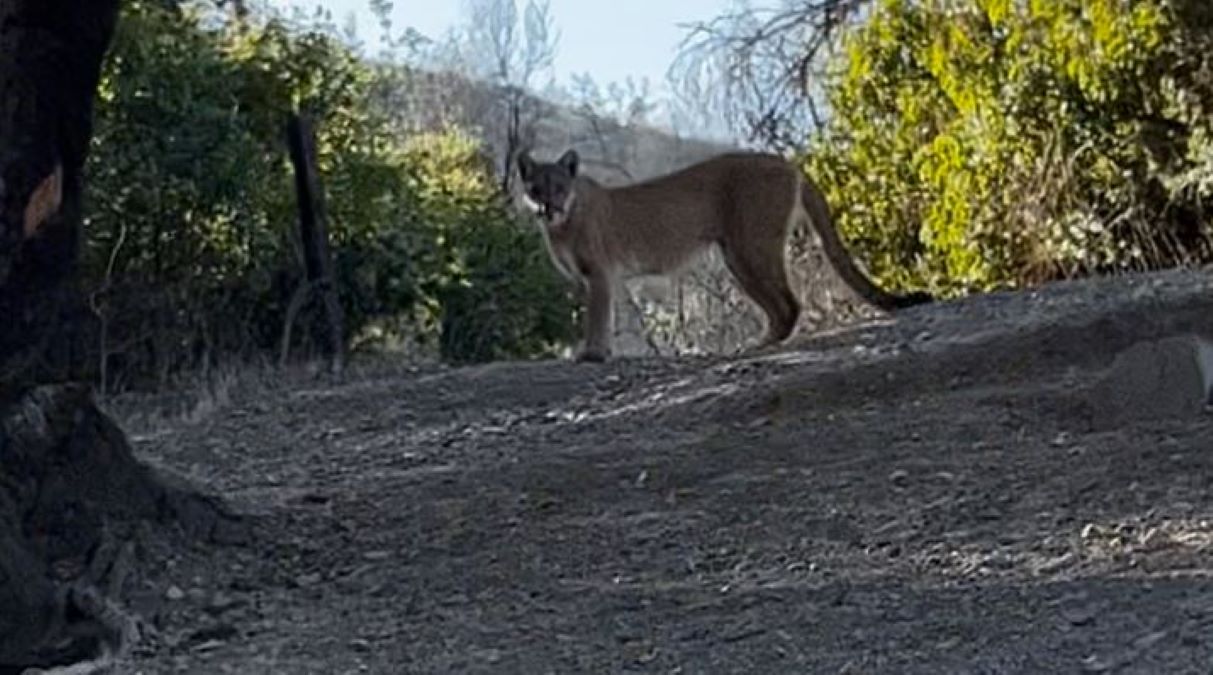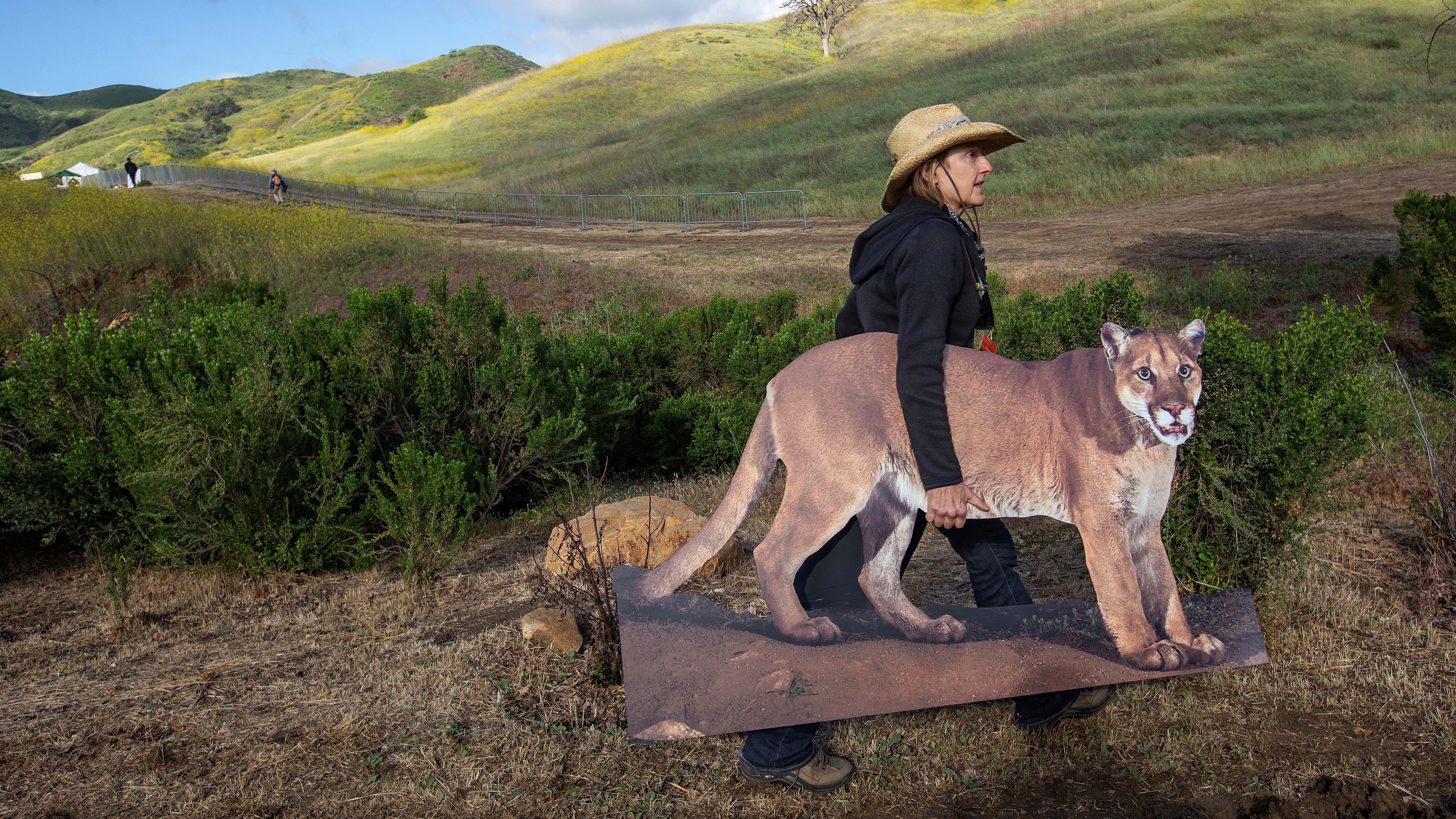A home security camera captured video of a mountain lion on an evening stroll through a Hollywood Hills neighborhood and the big cat's too-close-for-comfort encounter with a resident and his dog.
The video showed a homeowner and his dog leave home for a walk when the dog appears to freeze at the sight of the large mountain lion. The mountain lion paced in front of the home, its eyes glowing in the darkness.
The man said they were about 6 feet away from the mountain lion. At first, he wasn't sure what he was seeing in the dim evening light.
Get top local stories in Southern California delivered to you every morning. >Sign up for NBC LA's News Headlines newsletter.
"Terrifying," said the homeowner, who asked not to be identified. "I was looking at him. 'Is that a dog? What is that?'
"It kind of took me a second to realize it was a lion. It was not being aggressive. The dog had stopped barking, and they were just like staring each other down."
The unsettling encounter happened at about 7:30 p.m. Tuesday near Lake Hollywood Drive off of Barham Boulevard. The neighborhood of narrow winding streets is above the Lake Hollywood Reservoir below the Hollywood sign.
"I came out into the driveway and tried to make myself as big as possible and made as much noise as I could," the homeowner said.
Wildlife officials encourage anyone who encounters a mountain lion to remain calm and not to run. Running can trigger a chase-catch-kill response.
The animal appeared to be wearing a tracking collar, suggesting it is part of a Southern California study of mountain lions and their habitat in a region where wilderness and residential development collide. The most famous member of that study is P-22, who has been spotted in the Hollywood Hills, Los Feliz and elsewhere, but residents said they've seen a couple of mountain lions in the area over the past few weeks.
There are about 4,000 to 6,000 mountain lions in California, but wildlife officials call that a crude estimate without an ongoing statewide study. More than half of the state is considered prime habitat for the big cats, which can be found wherever deer are present.
The California Department of Fish and Wildlife receives hundreds of mountain lion sighting reports each year. Few result in mountain lions being identified as posing an imminent threat to public safety, the department said. Mountain lion attacks on humans are extremely rare and their nature is to avoid humans.
It is estimated that the mountain lion population in the Santa Monica Mountains could become extinct within 50 years without an influx of genetic diversity. The lions are largely isolated due to freeways that act as barriers to movement across the region.
Conservationists hope the $85 million Wallis Annenberg Wildlife Crossing, which will span the 101 Freeway in Liberty Canyon near Agoura Hills, will alleviate the problem when it is completed in 2025. It will be the largest crossing of its kind in the world -- a fully landscaped passage for wildlife that will stretch 210 feet over 10 lanes of highway and pavement.
The crossing aims to provide a connection between the small population of mountain lions in the Santa Monica Mountains and the larger and genetically diverse populations to the north.
Researchers believe P-22 came from the Santa Monica Mountains. He somehow crossed the 405 and 101 freeways into Griffith Park about 10 years ago.
The National Park Service tracks mountain lions to study how they survive in urbanized landscapes. The GPS radio collars provide researchers with detailed information about the mysterious big cats.
Here's a full list of recommendations from the California Department of Fish and Wildlife of what to do during a mountain lion encounter:
- Do not hike, bike, or jog alone. Stay alert on trails.
- Avoid hiking or jogging when mountain lions are most active – dawn, dusk, and at night.
- Keep a close watch on small children.
- Off leash dogs on trails are at increased risk of becoming prey for a mountain lion.
- Never approach a mountain lion. Give them an escape route.
- DO NOT RUN. Stay calm. Running may trigger chase, catch and kill response. Do not turn your back. Face the animal, make noise and try to look bigger by waving your arms, or opening your jacket if wearing one; throw rocks or other objects. Pick up small children.
- Do not crouch down or bend over. Squatting puts you in a vulnerable position of appearing much like a 4-legged prey animal.
- Be vocal; however, speak calmly and do not use high pitched tones or high pitch screams.
- Teach others how to behave during an encounter. Anyone who runs may initiate an attack.
- If a lion attacks, fight back. Research on mountain lion attacks suggests that many potential victims have fought back successfully with rocks, sticks, garden tools, even an ink pen or bare hands. Try to stay on your feet. If knocked down, try to protect head and neck.
- If a mountain lion attacks a person, immediately call 911.
- Report unusual mountain lion behavior to your local CDFW regional office.



